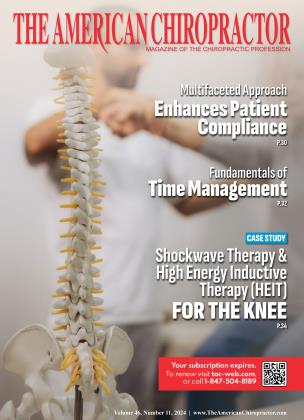Boost Patient Care with Balance and Cognitive Therapy
IN BRIEF
NEUROLOGY
Moe Pisciottano
DC
In the realm of chiropractic care, integrating innovative technologies and therapeutic modalities is pivotal in optimizing patient outcomes. One such advancement gaining traction in chiropractic practices is balance and cognitive therapy facilitated by cutting-edge equipment.
Scientific research underscores the efficacy of balance and cognitive therapy in enhancing musculoskeletal health and overall well-being. Studies have demonstrated that targeted balance-training interventions improve postural control, reduce fall risk, and enhance functional mobility in diverse patient populations, including older adults, individuals with neurological conditions, and athletes.1-2
Furthermore, cognitive-motor dual-task training has been shown to enhance cognitive function and executive control, leading to improved attention, processing speed, and task-switching abilities.3-4 By integrating cognitive challenges into balance exercises, you stimulate neural pathways associated with motor coordination and cognitive processing, promoting holistic brain-body integration and resilience.
In the context of chiropractic practice, balance and cognitive therapy offers a unique opportunity to expand treatment modalities and address the interconnectedness of musculoskeletal
health and neurological function. Chiropractors can leverage balance and cognitive therapy to complement traditional spinal adjustments and rehabilitation protocols, offering patients a comprehensive approach to musculoskeletal wellness.
By incorporating balance and cognitive therapy into their practices, chiropractors can empower patients to achieve optimal physical and cognitive function, reduce the risk of falls and injuries, and enhance overall quality of life. As evidence-based interventions continue to shape the landscape of chiropractic care, balance and cognitive therapy emerges as a valuable tool for promoting holistic health and well-being.
Dr. Moe Pisciottano is the CEO of the Pro-Adjuster Group and has been a practicing chiropractor in Pittsburgh, Pennsylvania, for 35 years. Dr. Pisciottano is the first and only chiropractor to receive the coveted Ernst and Young Entrepreneur of the Year award. To learn more, visit www.learnproadjuster.com
References:
1. Lubetzky-Vilnai A, Kartin D. The effect of balance training on balance performance in individuals poststroke: a systematic review. J Neurol Phys Ther. 2010 Sep;34(3): 127-37. doi: 10.1097/ NPT.0b013e3181ef764d. PMID: 20716987.
2. Franco R, de Souza Moreira B, Mendonca VA, de Oliveira CQ, Carvalho AC, De Oliveira, DG. Effects of balance training in elderly people with sarcopenia: a randomized controlled trial. European Journal of Physical and Rehabilitation Medicine. 2020:56(5): 676-684.
3. Dunsky A. The effect of balance and coordination exercises on quality of life in older adults: a mini-review. Front Aging Neurosci. 2019 Nov 15;11:318. doi: 10.3389/fnagi.2019.00318. PMID: 31803048; PMCID: PMC6873344.
4. Wang Y, Yang Q, Tian C, Zeng J, Yang M, Li J, Mao J. A dual-task gait test detects mild cognitive impairment with a specificity of 91.2. Front Neurosci. 2023 Feb 7:16:1100642. doi: 10.3389/ fnins.2022.1100642. PMID: 36825213; PMCID: PMC994294
 View Full Issue
View Full Issue









